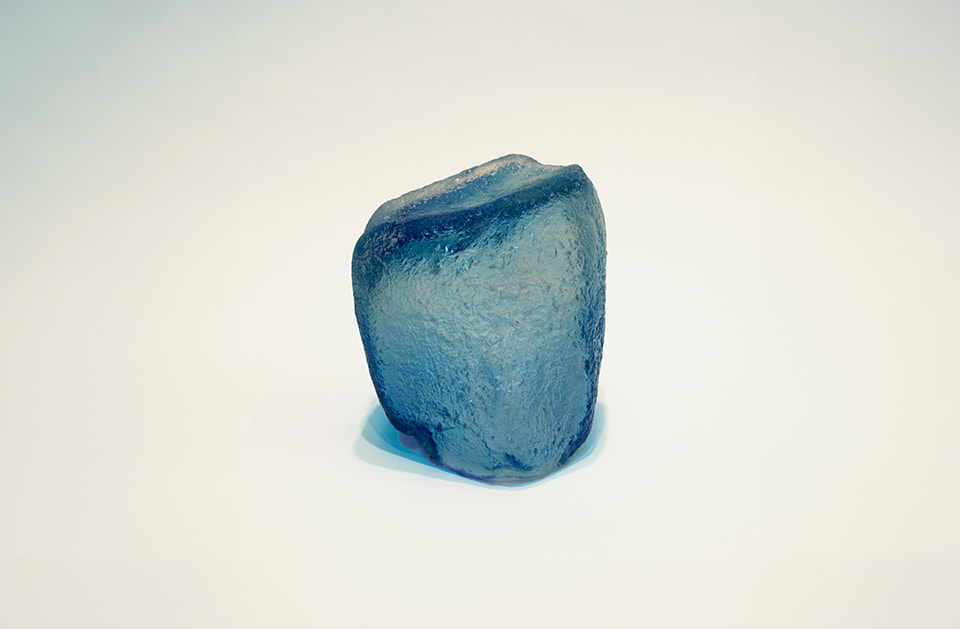September 8th – October 28, 2023
PROXYCO Gallery, 121 Orchard Street, New York, NY 10002
PROXYCO Gallery is pleased to present a solo exhibition by Dolores Furtado: Vestigio
Infatuated with materials and delighted by experimentation, Dolores Furtado creates sculptural works that invite viewers to question how they were made. In Vestigio, Furtado’s first exhibition with PROXYCO, a new series of glass works brings another question to the fore: not just how, but when were these objects made? Like artifacts recovered from a preserved ancient city—Pompeii, maybe, or perhaps more aptly, Atlantis—Furtado’s sculptures are at once pristine and timeworn; sumptuous and rough. Ancient in shape yet futuristic in color, their place of origin is as mysterious as the process by which they were created. (Although in actuality, the oldest works in the show date to 2022.) With forms as enigmatic as their materials, these works call to mind faraway lands and unknowable civilizations, representing a simultaneous transmutation and accumulation of time and matter.
Debuting in Vestigio, Furtado’s new body of work represents the fruits of a year-long residency she undertook at Brooklyn’s UrbanGlass in 2022. Representing myriad approaches, Furtado’s glass sculptures bear formal similarities to her work in paper and resin while charting new territory for her practice and pushing the limits of what the material itself can do. Some, such as Vision (2022), were created from molds that started as clay models. Many of these works bear traces of Furtado’s body, as in Secreto (2022), or graffiti, as in Destino (2022)—hidden elements that reward close, sustained viewing. Other pieces, such as Unidos (2022), originated from paper structures translated into glass via a meticulous casting process. Like many of Furtado’s paper works, this translation involves an inscrutable series of steps, yet, seemingly against all odds, the rough, gritty texture of paper pulp lingers in these sleek, translucent objects.
Still others, such as Vessel y Caramelero (2022) or Adrift (2022), are the product of glassblowing, a process so specific, so challenging, and so prone to accidents that to it feels almost mythic; anachronistic. While all Furtado’s glass pieces can be comfortably held, save for the almost human-scaled torso of Lover (2022), the blown works belie the process by which they were made, standing proudly with legible heft. Defying expectations of typical glass objects, characterized by sensuous, smooth finishes, undulating curves, and a legible fragility, Furtado’s pieces have a gruff, awkward quality. Lids do not quite fit the vessels they match; bodily forms appear dislocated or fractured. While all Furtado’s glass works are relics of her experiments with the experts at UrbanGlass, they read like relics of a past world, too, as if recently unearthed from an archaeological dig.
In the center of the gallery stand the remnants of a towering castle wall. Or perhaps it’s a portion of a grand Victorian painted lady with a turret, or a deconsecrated church bell tower. Titled Do you remember? (2023), the wall is punctured by an odd pair of windows, one amusingly small and the other generously large, arranged idiosyncratically. They conjure other visions of the structure to which the wall may belong. (Perhaps another small window perforated the top of the tower, creating a singular vantage point for an imprisoned princess or an eccentric agoraphobic.) The wall’s façade is speckled with subtle graffiti, calling to mind improvisational drawings made in wet cement or initials carved in porous walls by carefree teenagers. Despite these evocative scrawls, the work was built here in the gallery just weeks ago and only bears traces of the artist’s own hand as she built up layers of paper pulp before sacrificing the structure to the elements, hoping it would dry in time to stand. As with the glass works, Do you remember? provokes questions about what is old, what is new, and our own relative positionality.
Alongside the glass works are a selection of Furtado’s other recent recycled paper sculptures, such as Flask (2023). Their uncanny similarities to the works rendered in glass—in scale, texture, weightiness—underline the elemental starting places of both series, one created with plant fiber and water, the other with sand and fire. If Vestigio collapses past and present, it also brings the constancy of nature and its own cyclical processes into focus. As if calling upon us to permit our household treasures and homes to be overtaken by nature, Furtado’s work collapses time not just from the present to the ancient but to the primordial.
— Emily Markert

